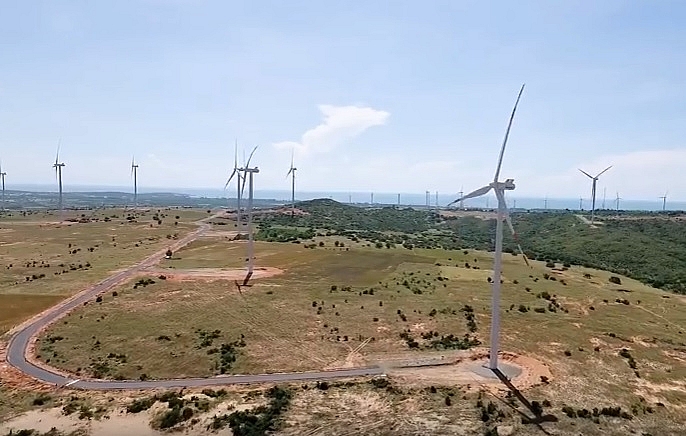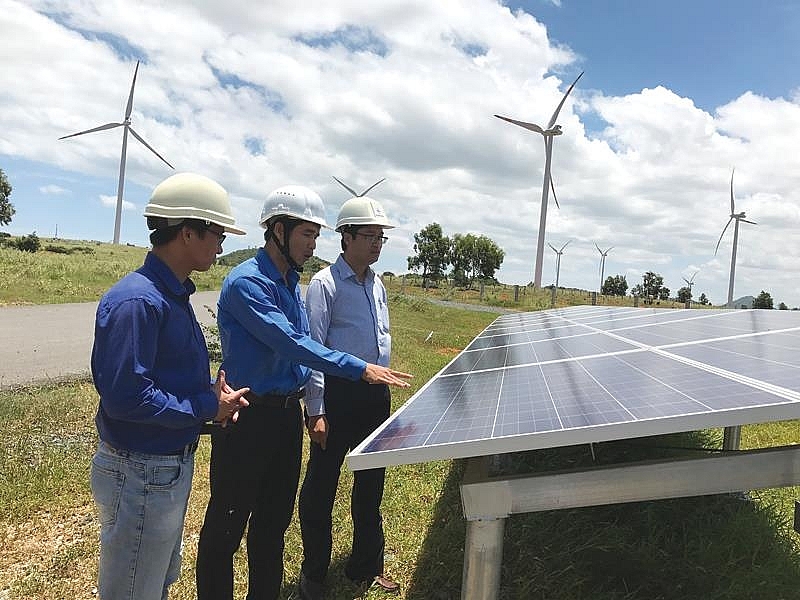Renewables lag behind the potential
 |
Standing under the line of 12 wind turbines that make up the Phu Lac wind farm, Bui Van Thinh, chairman of Thuan Binh Wind Power JSC, told VIR that due to the purchasing price of 7.8 US cents per kilowatt-hour (kWh), his company has not made a profit in nine years of operation.
The Phu Lac wind farm project’s phase 1 had the total investment of nearly VND1.1 trillion ($48.7 million), with 85 per cent of the sum raised in loans from the German development bank KfW. In September 2016, the plant went into commercial operation and was connected to the national grid.
Thinh said that he had not lost faith, but Thuan Binh Wind Power JSC’s ambitions to expand with further wind power projects in Vietnam might fail if the price does not increase. Previously, the company had planned to develop four similar plants: two in the central provinces of Ninh Thuan and Binh Thuan and two in the Central Highlands provinces of Dak Lak and Gia Lai.
 |
Waiting for increased FiT
The Ministry of Industry and Trade (MoIT) has proposed that the government to increase the feed-in tariff (FiT) for wind power from onshore wind power plants to 8.77 cents from the current 7.8 cents per kWh. According to the MoIT, with the existing wind power FiT, these plants have difficulties recovering their investment capital. The proposal would help investors develop new projects or expand existing ones. In addition, it would help operating projects by accelerating the speed at which they can recover their investment capital.
Vietnam’s wind market has yet to take off after the government first released incentives for wind power projects in 2011. Investors’ major concern is the price of their products. Many projects have been postponed because regulated prices were below production costs. For instance, the Mekong Delta province of Ben Tre licensed five wind power projects with a total capacity of 150 megawatts (MW), but investors have been waiting for the FiT to increase. An additional 19 wind power projects were registered in Binh Thuan, but they remain solely on paper.
Asked by VIR whether investors would consider leaving Vietnam’s wind sector, Morten Dyholm, vice president of Vestas Group, expressed his view that investors see great potential, huge demand, and strong political commitment in the country. He emphasised that wind power is one of the most competitive energy sources globally and one of the fastest-growing industries in the world. “Thus, global firms will not leave this market,” he said, adding that a series of petitions have already been submitted, but they are waiting for a hike in the FiT.
In a recent memorandum of understanding, Mainstream Renewable Power and GE Energy Financial Services agreed to invest around $2 billion in the construction of the 800MW Phu Cuong wind power project in Soc Trang, developed in co-operation with local partner Phu Cuong Group, which will remain involved in the project throughout its five development phases. The first phase, slated to produce 150-200MW, is expected to conclude its financing by the end of the year.
Bui Vinh Thang, business development manager of Mainstream Renewable Power, said that without a bankable power purchase agreement (PPA), the project would not be able to keep on track.
Opportunities for solar power?
Unlike wind power, solar power has become hotter than ever in Vietnam. The boom began when the Vietnamese government’s Decree No.11/2017/QD-TTg on mechanisms for encouraging the development of solar power in Vietnam was released. The list of solar projects registered by foreign investors in Vietnam has been growing consistently, including well known foreign names such as Tata Power, Sunseap Group, InfraCo Asia Development Pte., Ltd., ACWA Power, SY Panel Group, AIN Group, Siemens Gamesa Renewable Energy, and Gulf Energy Development.
Thuan Binh Wind Power JSC also plans to develop a 150MW solar power plant on the area the company had initially intended to use to expand the Phu Lac wind power plant. The construction of the solar power project will be implemented in three phases. The company is currently conducting the pre-feasibility study, an environmental impact assessment, and capital arrangement for the first phase of the project.
Thinh said that investing in solar power offered more benefits than wind power, because the regulated selling price is 9.35 cents per kWh.
The MoIT recently released impressive figures, as the total output of solar power projects approved to be added to the country’s Power Development Master Plan VII is quite large. The ministry approved more than 70 new projects to be put into operation before June 2019, with a total capacity of over 3,000MW. This amount far exceeds the estimated solar power output of 1,000MW until 2020 in the original master plan.
Under the prime minister’s Decision 11, solar power installations that reach their commercial operation date (COD) by June 30, 2019 are entitled to a FiT of 9.35 cents per kWh for a period of 20 years. “Where will the price go after that?” Do Duc Tuong from the United States Agency for International Development (USAID) asked, suggesting that a long-term and stable policy on solar power prices is needed to encourage investment.
In addition, solar investors are expressing concern about the limited transmission capacity. “The project developer is responsible for grid connection costs and risks. However, the PPA does not factor in project capacity, distance from existing transmission lines, and higher costs of installing transmission lines over longer distances,” noted international law firm Jones Day. The law firm went on to say that both wind and solar had bottlenecks yet to be solved, and the FiT, PPA and the MoIT’s draft circular guiding solar PPAs all play an important role by providing the basic framework for investment within the sector.
Baker McKenzie also pointed out that Decision 11 does not give early investors any specific assurances that they will receive no less favourable treatment in respect to the basic terms and conditions of their investment agreements and especially their PPAs than investors coming in after June 30, 2019, even if this means retroactive adjustments to the FiT.
The Government Office has issued Notice 174 requesting that the MoIT suspend approval of additional solar power plants pending the approval of a national master plan for the development of solar power, under which the MoIT has been tasked with formulating and presenting a new solar PPA to the prime minister.
Two weeks ago, the government released a notice saying it rejected a proposal to extend the deadline for the FiT in Ninh Thuan, crushing the hopes of investors to benefit from the FiT of 9.35 cents even if their projects reach their COD after June 30, 2019.
What the stars mean:
★ Poor ★ ★ Promising ★★★ Good ★★★★ Very good ★★★★★ Exceptional
Related Contents
Latest News
More News
- Schaeffler reports strong early output from Dong Nai solar project (December 12, 2025 | 15:16)
- Forestry conference highlights biodiversity and sustainability goals (December 09, 2025 | 13:35)
- Home Credit honoured among top 10 sustainable companies in trade and services (December 09, 2025 | 12:18)
- SCG and seven member companies honoured in Top 100 Sustainable Businesses 2025 (December 08, 2025 | 09:00)
- Nestlé Vietnam pioneers sustainable development and promotes business connections (December 06, 2025 | 12:09)
- CSI 2025 highlights rise of Vietnam’s green champions (December 06, 2025 | 09:00)
- Acecook Vietnam named among top 100 sustainable businesses (December 06, 2025 | 08:00)
- Vietnam’s forest carbon credits draw global interest (December 05, 2025 | 17:41)
- Coro Energy to launch BESS Pilot in Vietnam (December 04, 2025 | 15:12)
- Vietnam strengthens energy storage pathway (December 04, 2025 | 15:05)

 Tag:
Tag:






















 Mobile Version
Mobile Version